| Vintage Pulp | Mar 26 2018 |

Pam Grier was the undisputed ruler of the blaxploitation realm.
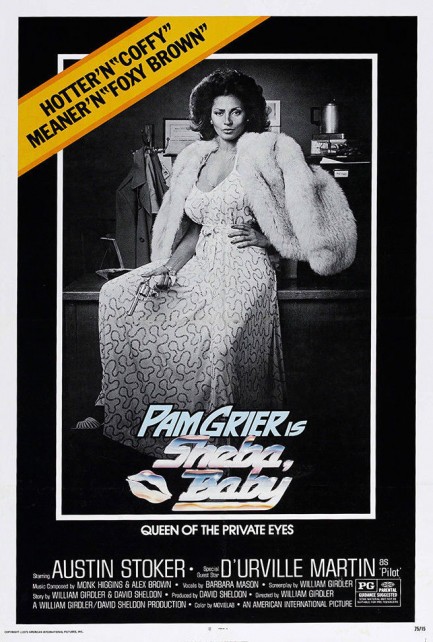
The arc of Pam Grier's blaxploitation career is interesting. To us it seems pretty clear that once her studio American International realized they had a true star on their hands the projects they cultivated for her moved toward the cinematic center and became tame and uninspiring. We noted this when we talked about 1975's Friday Foster a while back. Sheba Baby, which was made the same year and premiered in the U.S. today, suffers from the same problem. It's too cute and too palatable, too eager to please in its attempt to draw in mainstream audiences. Grier loses her grit.
She plays Sheba Shayne, whose father is harassed by organized crime hoods and needs help to fight their plot to take over his business. Grier leaves her Chicago detective agency and heads down south to Louisville, Kentucky to kick ass and take names. The hoods are black men from around the way, but the real villain is a white guy on a yacht in the river. He's archetypal. He could just as well be a white guy in a mansion on a hill, or in a penthouse uptown. Whoever and wherever he is, he's going down hard and it's going to hurt.
The importance of blaxploitation is that it centered stories on the black experience—family, neighborhood, crime, racism, and the predations of America's two-tiered policing and court systems. This focus on core black issues existed even in films that represented alternate realities, such as horror and martial arts blaxploitation. The eventual sanitization of the genre was due to pressure from two directions at once: from the mainstream to avoid alienating white audiences, and from the black counterculture to avoid caricatured portrayals of blacks. Caught between these two forces, the center of blaxploitation shifted.
The importance of blaxploitation is that it centered stories on the black experience—family, neighborhood, crime, racism, and the predations of America's two-tiered policing and court systems. This focus on core black issues existed even in films that represented alternate realities, such as horror and martial arts blaxploitation. The eventual sanitization of the genre was due to pressure from two directions at once: from the mainstream to avoid alienating white audiences, and from the black counterculture to avoid caricatured portrayals of blacks. Caught between these two forces, the center of blaxploitation shifted.
Meanwhile, inside the subculture, initial euphoria at seeing black stories onscreen evolved into annoyance that the control and profits belonged almost exclusively to white men. It seemed like a plantation system on celluloid, and helped take the bloom off the rose. 1976 and 1977 would remain strong years for the genre, but by 1978 blaxploitation, as it was generally agreed to exist, would all but disappear. Sheba Baby is an important film in the pantheon, but in watching it you also see the genre losing its bite.
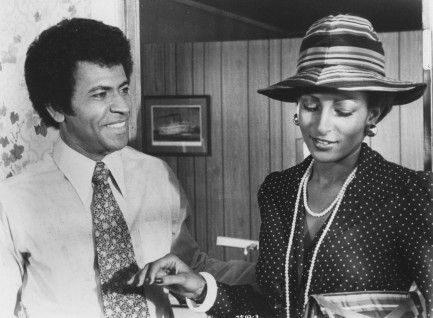
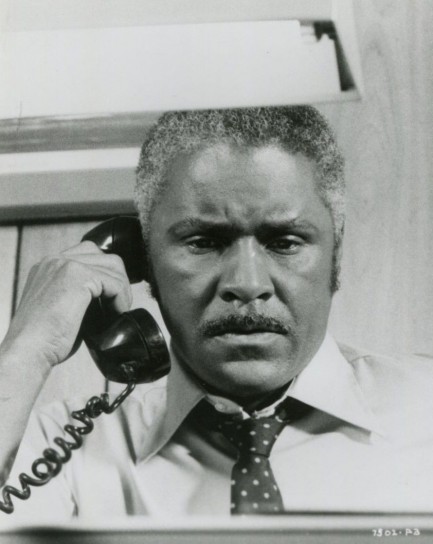
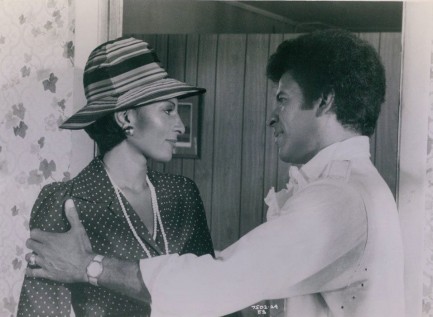
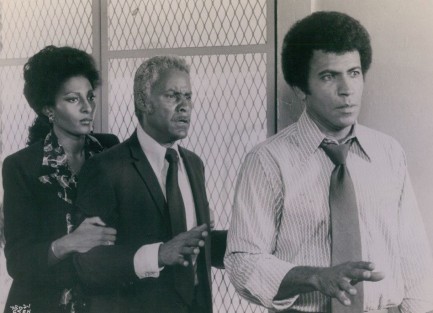
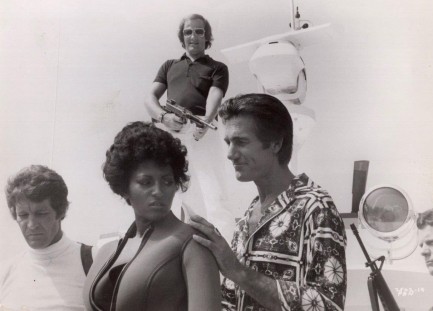
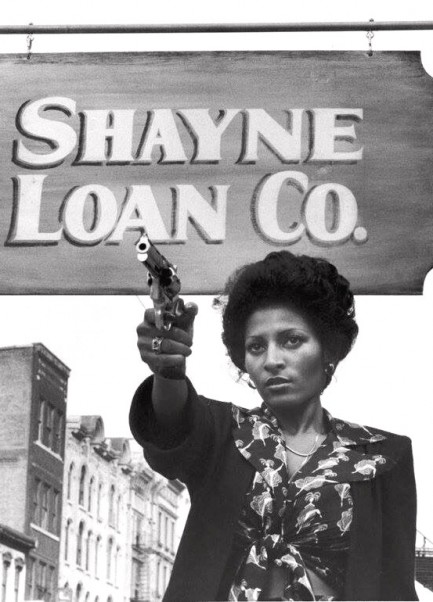
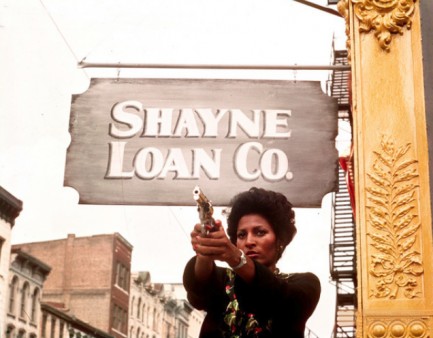

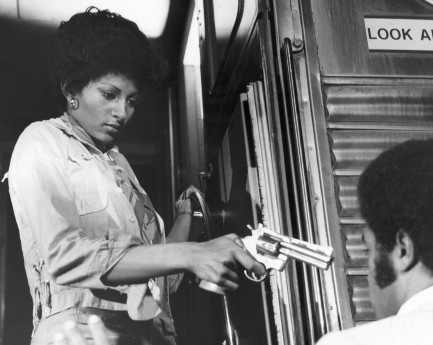

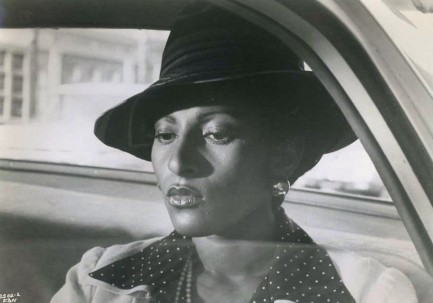
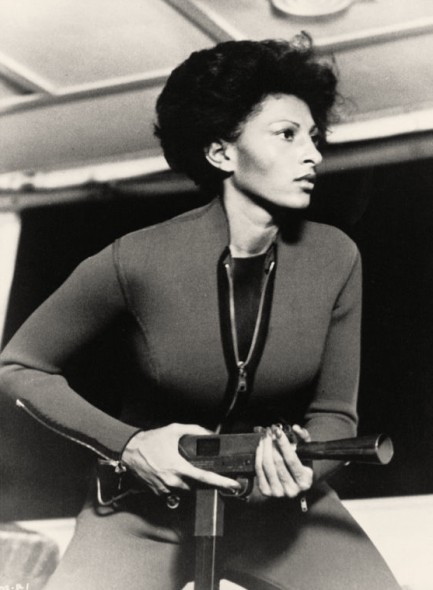
| Vintage Pulp | Dec 20 2017 |

Geez, everyone's a damn critic. I mean, look around. I play the blues for a reason.
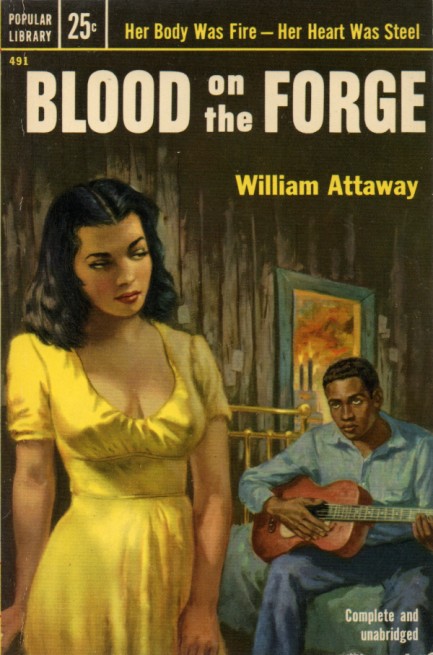
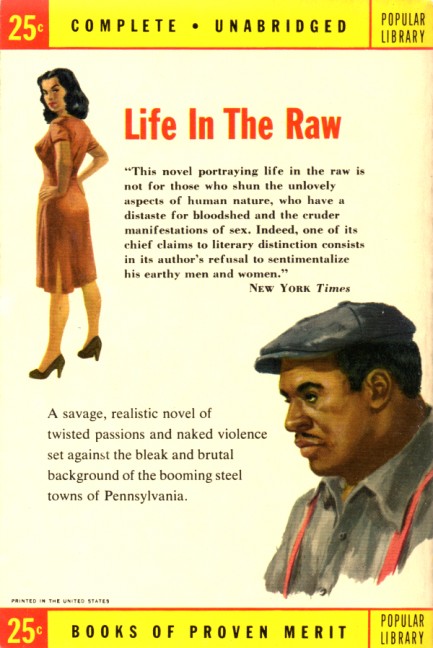
Chicago based author William Attaway's Blood on the Forge is another of those highly serious literary novels that got the good-girl-art cover treatment. Numerous previously published authors were repackaged in this way during the 1950s. We're talking everyone from George Orwell to Aristarchus of Samos. This Popular Library edition is from the heyday of the makeover era—1953—but the book first appeared in 1941. It's about African American sharecroppers during the early twentieth century leaving their agrarian existence in Kentucky and heading to West Virginia, where they seek better lives and something closer to equality (the rear cover says Pennsylvania, but that happens much later in the story). This era is known historically as the Great Migration, when a lot of blacks got the hell out of the South and the increasingly vicious Jim Crow culture that thrived after slavery. The characters in Blood on the Forge find, like most real life migrants did, that the North is also unfair and difficult.
The cover art isn't as much of a stretch as it often is with these pulped up versions. The guitar player is Melody Moss, a major character, and the woman is Anna, who in the narrative is a Mexican girl of fourteen, but is depicted as well above the age of consent here. It's a pretty nice piece of art, though by an unknown (Ray Johnson? Owen Kampen?). As for the actual fiction, it was neglected for decades but it's now considered a literary classic and Attaway is recognized as an important figure of the Black Chicago Renaissance. Fitting, because Attaway was a real Renaissance man. He stopped writing novels after Blood on the Forge and moved into music and writing screenplays for radio, films, and TV. In 1957 he published the Calypso Song Book, a compendium of tunes he had collected. He also wrote for Harry Belafonte, including the classic "Banana Boat Song (Day O).” By the end of his career he had penned over 500 songs. You have to be impressed.
The cover art isn't as much of a stretch as it often is with these pulped up versions. The guitar player is Melody Moss, a major character, and the woman is Anna, who in the narrative is a Mexican girl of fourteen, but is depicted as well above the age of consent here. It's a pretty nice piece of art, though by an unknown (Ray Johnson? Owen Kampen?). As for the actual fiction, it was neglected for decades but it's now considered a literary classic and Attaway is recognized as an important figure of the Black Chicago Renaissance. Fitting, because Attaway was a real Renaissance man. He stopped writing novels after Blood on the Forge and moved into music and writing screenplays for radio, films, and TV. In 1957 he published the Calypso Song Book, a compendium of tunes he had collected. He also wrote for Harry Belafonte, including the classic "Banana Boat Song (Day O).” By the end of his career he had penned over 500 songs. You have to be impressed.
| Femmes Fatales | Aug 22 2016 |

You know that whole forbidden fruit concept? I've never agreed with it.

Above, a nice shot of blaxploitation star Marilyn Joi, aka Tracy King, who appeared in notable efforts such as Black Samurai and the unforgettable Ilsa, Harem Keeper of the Oil Sheiks, but is probably best known as Cleopatra Schwartz from the mainstream comedy Kentucky Fried Movie. This photo appeared on the cover of Players magazine in 1980.
| Mondo Bizarro | Apr 28 2016 |

Ghost hunter hit by train while searching for creature said to lure victims in front of trains.


A few days ago in Louisville, Kentucky a woman was hit and killed by a train, but this was no ordinary accident. Twenty-six-year-old Roquel Bain and her boyfriend had come to Louisville to take part in a ghost hunting tour of an abandoned sanitarium, but first decided to investigate a local legend—the Pope Lick Goatman. This cryptid is said to use a hypnotic gaze to lure victims onto the Pope Lick Trestle, where they are then hit by a passing train. Bain and her companion walked onto the trestle and shortly thereafter a train came along, as they tend to do about every half hour, according to locals. Bain's boyfriend was able to hang from the edge of the structure as the train passed but Bain was hit and hurled one hundred feet onto the valley floor.
The Goatman legend has the hallmarks of a high school stunt that grew over the course of years. Since locals are aware that trains pass frequently, we suspect the game decades ago was to simply cross the trestle before one came along. A bridge that long, a schedule that tight, it was a reasonable bet everyone would have to run for their lives at some point. Fun and games. But dangerous ones, with occasional 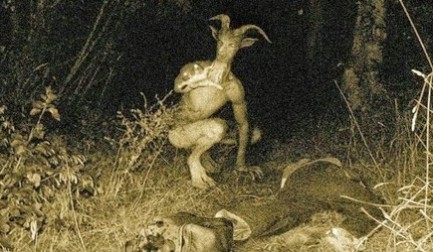 deaths. At that point the Goatman story probably came into being to provide motivation to risk the trestle, or maybe someone just dreamed it up to explain why people were always crazy enough to be up there. “There must be some weird lure for these people,” someone comments. “Like what? A siren?” someone replies sarcastically. “Hah hah. Yeah. Well, there's no water up there. Plenty of cows and goats, though. Half man, half goat.”
deaths. At that point the Goatman story probably came into being to provide motivation to risk the trestle, or maybe someone just dreamed it up to explain why people were always crazy enough to be up there. “There must be some weird lure for these people,” someone comments. “Like what? A siren?” someone replies sarcastically. “Hah hah. Yeah. Well, there's no water up there. Plenty of cows and goats, though. Half man, half goat.”
 deaths. At that point the Goatman story probably came into being to provide motivation to risk the trestle, or maybe someone just dreamed it up to explain why people were always crazy enough to be up there. “There must be some weird lure for these people,” someone comments. “Like what? A siren?” someone replies sarcastically. “Hah hah. Yeah. Well, there's no water up there. Plenty of cows and goats, though. Half man, half goat.”
deaths. At that point the Goatman story probably came into being to provide motivation to risk the trestle, or maybe someone just dreamed it up to explain why people were always crazy enough to be up there. “There must be some weird lure for these people,” someone comments. “Like what? A siren?” someone replies sarcastically. “Hah hah. Yeah. Well, there's no water up there. Plenty of cows and goats, though. Half man, half goat.”Then in 1988 came director Ron Schildknecht's 16-minute movie The Legend of the Pope Lick Monster, and the story of the Goatman began to spread. Of the people who visit from outside the area, many arrive believing the rickety-looking trestle is abandoned, which Bain may have thought as well. The crossing still would be dangerous without a train, but at least you could do it at a comfortable pace. The story of Bain's death caught our eye for two reasons. First because PSGP was born and raised in southern Ohio and had heard of this bridge. He never braved the crossing—before interlopers from out of state began  visiting the site regularly, Louisville locals would have viewed an Ohio kid in their backwoods as a good candidate for an ass-whipping. They probably still do.
visiting the site regularly, Louisville locals would have viewed an Ohio kid in their backwoods as a good candidate for an ass-whipping. They probably still do.
 visiting the site regularly, Louisville locals would have viewed an Ohio kid in their backwoods as a good candidate for an ass-whipping. They probably still do.
visiting the site regularly, Louisville locals would have viewed an Ohio kid in their backwoods as a good candidate for an ass-whipping. They probably still do.The second reason this story struck us is because we just wrote about personal risk-taking a few days ago, and this is obviously the flipside of it—risk is exhilarating but it can get you hurt or killed. Bain and her boyfriend were just trying catch a thrill, which we totally understand. Hell, we don't see it as very different from dirt biking or ocean kayaking, but that's just us. You have to feel bad for everyone involved, though. Wait a sec—did we really just write that? Last time something like this happened we thought it was hilarious. Are we getting soft? Damn. Blame it on the Pulp Intl. girlfriends.
| Vintage Pulp | Dec 9 2015 |

My husband is down the chimney right now, but when he gets back you’re definitely going on his naughty list.
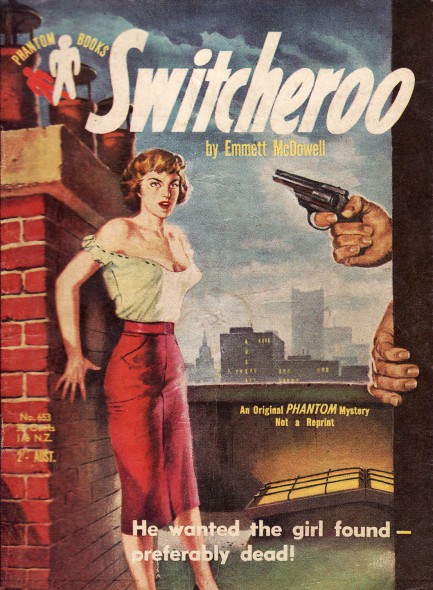
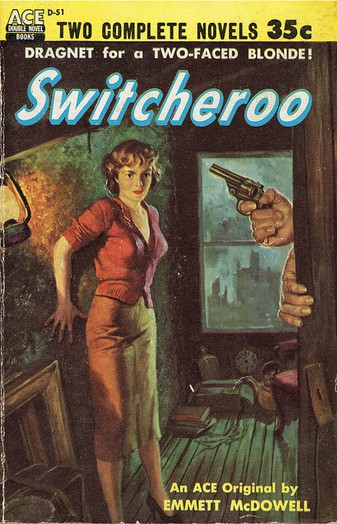 Switcheroo is a detective yarn set in the unlikely locale of Louisville, Kentucky, but since author Emmett McDowell lived there most of his life, it’s no surprise. Nearly all his writing featured Kentucky in some form, and he even branched out into non-fiction and wrote a Civil War history of Louisville. Switcheroo was his first book, and originally appeared in 1954 as one half of an Ace Double, with Lawrence Treat’s Over the Edge on the flipside. The edition you see above is from the Australian imprint Phantom Books and was published in 1955. Basically, low rent detective Jaimie McRae is hired to locate a missing woman. All the usual benchmarks are there—unhelpful cops, a hot secretary and girl Friday, and unexpected developments. It earned lukewarm reviews all the way around. The uncredited art for Phantom closely resembles the original Victor Olson art for the Ace Double edition, which you see above and right, but we doubt Olson had a hand in the rooftop makeover.
Switcheroo is a detective yarn set in the unlikely locale of Louisville, Kentucky, but since author Emmett McDowell lived there most of his life, it’s no surprise. Nearly all his writing featured Kentucky in some form, and he even branched out into non-fiction and wrote a Civil War history of Louisville. Switcheroo was his first book, and originally appeared in 1954 as one half of an Ace Double, with Lawrence Treat’s Over the Edge on the flipside. The edition you see above is from the Australian imprint Phantom Books and was published in 1955. Basically, low rent detective Jaimie McRae is hired to locate a missing woman. All the usual benchmarks are there—unhelpful cops, a hot secretary and girl Friday, and unexpected developments. It earned lukewarm reviews all the way around. The uncredited art for Phantom closely resembles the original Victor Olson art for the Ace Double edition, which you see above and right, but we doubt Olson had a hand in the rooftop makeover. 



































































